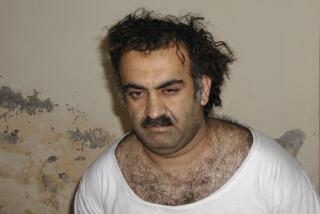New Legal Papers Reveal Charges Against Detainee
WASHINGTON — The prisoner at Guantanamo Bay, Cuba, whose case has temporarily caused the shutdown of military tribunals for suspected terrorists has admitted that he was a driver for Osama bin Laden but has denied having other ties to the Al Qaeda network, according to court papers released Tuesday.
Salim Ahmed Hamdan, a 35-year-old from Yemen, said he tried to flee Afghanistan when war broke out there after Sept. 11, 2001, but was captured and shipped to the prison camp at the U.S. naval base in Cuba, where he was beaten by American soldiers. He said he was held for months in solitary confinement and threatened with more harm if he did not plead guilty to war crimes.
But according to military charges against him that also were included in the new legal papers, Hamdan was so close to Bin Laden as his driver and bodyguard that he knew the terrorist leader was behind the bombings of two U.S. embassies in Africa in 1998, the assault on the U.S. Navy destroyer Cole in Yemen in 2000 and the Sept. 11 airplane attacks in New York and at the Pentagon.
Furthermore, the military said Hamdan routinely delivered weapons, ammunition and other supplies to Al Qaeda members, attended a terrorist training camp in Afghanistan, and accompanied Bin Laden on trips where he gave speeches encouraging “martyr missions.”
The new documents were in a petition filed by Hamdan’s lawyers asking the U.S. Supreme Court to permanently shut down the military commissions, also known as tribunals, at Guantanamo Bay. In their place, the defense lawyers want detainees tried in a military court-martial or a federal court to better protect their rights.
Hamdan is one of four prisoners whose cases were being prepared for tribunals, and the documents for the first time spotlight the government’s evidence as well as his defense.
“Mr. Hamdan wants a trial,” his military lawyer, Navy Lt. Cmdr. Charles Swift, said in an interview Tuesday. “But not a trial without an independent judiciary and where you can’t confront the evidence against you. Is that really a trial?”
Under the tribunals, prisoners would be prosecuted and defended by U.S. military lawyers, and before a judge and jury that also wore the U.S. uniform.
Pretrial hearings were underway, with the first tribunal expected in December or January, until U.S. District Judge James Robertson in Washington ruled Nov. 8 that tribunals were invalid under U.S. and international law. Days later, the Pentagon announced that the entire system was being put on hold at Guantanamo Bay, home to about 550 prisoners.
The government appealed the ruling to the U.S. Circuit Court of Appeals for the District of Columbia, a process that could take two years. Now, Hamdan’s lawyers are trying to speed up that timetable by appealing directly to the Supreme Court.
In his request to the high court, Swift attached a copy of a four-page affidavit that Hamdan signed in February, in which he maintained that he was not a Bin Laden operative but instead had gone from Yemen to Afghanistan to work as a commercial driver to support his young family.
“I have never been a member of Al Qaeda and I am not a terrorist,” Hamdan said.
He said he met a friend in Afghanistan who took him to the terrorist chieftain in 1996. “Osama bin Laden offered me a job as a driver on a farm he owned, bringing Afghani workers from the local village to work and back again,” Hamdan said. “After about seven months, Osama bin Laden began to have me drive him to various places.”
He said he was still driving for Bin Laden in October 2001 when the U.S. military “began its offensive” in Afghanistan, and that “the last time I was with Bin Laden was in Kabul.”
Hamdan’s wife and daughter made it to Pakistan, but he stayed in Afghanistan to sell his car to raise money for a taxi service in Yemen, he said. But then he was captured by local soldiers, he said, who were “looking for Arabs to sell to American forces.” He said he was sold for $5,000.
“Despite the fact that I cooperated with the Americans, I was physically abused,” he said. He was transported in a vehicle “in positions that caused me physical agony in my back” and was “dressed in only bright blue overalls in sub-freezing temperatures and was very cold.”
“When I did not know the answers to the investigators’ questions, the soldiers would strike me with their fists and kick me with their feet.... When I took them places I had driven Osama bin Laden, they would threaten me with death, torture or prison when I did not know the answers to their questions. One of their methods to threaten was to put a pistol on the table in front of me and show me the gun and ask, ‘What do you think?’ ”
Swift said he had never seen physical wounds on his client’s body. But, he said, “I have interviewed people who would corroborate his story.”
Hamdan said he was flown to Guantanamo Bay in June 2002. He said he was repeatedly questioned by “FBI and Arab police forces.” Twice, he said, he was allowed to phone his wife “to calm her.”
Interrogators said that if he testified against other detainees, he would be released and perhaps given American citizenship, he said. He also was given a statement to sign in which he would plead guilty to war crimes. When he refused, he was taken to a solitary cell at the prison in December 2003.
Swift said he has visited Hamdan’s family in Yemen, including his client’s second daughter, the youngest, whom Hamdan has yet to meet. He described Hamdan as a loyal husband and father, as a “Muslim but not a zealot.”
But the government sees him differently.
“Hamdan is a trained Al Qaeda member/affiliate,” the government said in its documents. “He was trained to use rifles, handguns and machine guns.”
More to Read
Sign up for Essential California
The most important California stories and recommendations in your inbox every morning.
You may occasionally receive promotional content from the Los Angeles Times.











